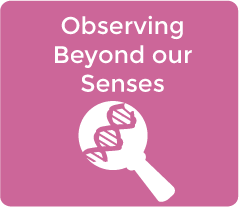CCC1 Crosscutting Concept 1 – Patterns
 see.isbscience.org/ngss/ccc1/
see.isbscience.org/ngss/ccc1/“Patterns exist everywhere—in regularly occurring shapes or structures and in repeating events and relationships. For example, patterns are discernible in the symmetry of flowers and snowflakes, the cycling of the seasons, and the repeated base pairs of DNA.” (p. 85)
While there are many patterns in nature, they are not the norm since there is a tendency for disorder to increase (e.g. it is far more likely for a broken glass to scatter than for scattered bits to assemble themselves into a whole glass). In some cases, order seems to emerge from chaos, as when a plant sprouts, or a tornado appears amidst scattered storm clouds. It is in such examples that patterns exist and the beauty of nature is found. “Noticing patterns is often a first step to organizing phenomena and asking scientific questions about why and how the patterns occur.” (p. 85)
“Once patterns and variations have been noted, they lead to questions; scientists seek explanations for observed patterns and for the similarity and diversity within them. Engineers often look for and analyze patterns, too. For example, they may diagnose patterns of failure of a designed system under test in order to improve the design, or they may analyze patterns of daily and seasonal use of power to design a system that can meet the fluctuating needs.” (page 85-86)
Patterns figure prominently in the science and engineering practice of “Analyzing and Interpreting Data.” Recognizing patterns is a large part of working with data. Students might look at geographical patterns on a map, plot data values on a chart or graph, or visually inspect the appearance of an organism or mineral. The crosscutting concept of patterns is also strongly associated with the practice of “Using Mathematics and Computational Thinking.” It is often the case that patterns are identified best using mathematical concepts. As Richard Feynman said, “To those who do not know mathematics it is difficult to get across a real feeling as to the beauty, the deepest beauty, of nature. If you want to learn about nature, to appreciate nature, it is necessary to understand the language that she speaks in.”
The human brain is remarkably adept at identifying patterns, and students progressively build upon this innate ability throughout their school experiences. The following table lists the guidelines used by the writing team for how this progression plays out across K-12, with examples of performance expectations drawn from the NGSS.






